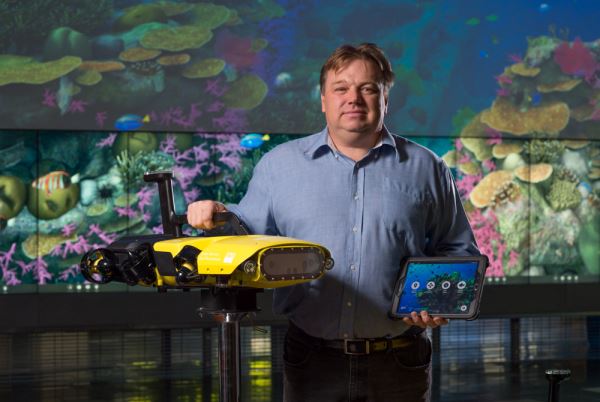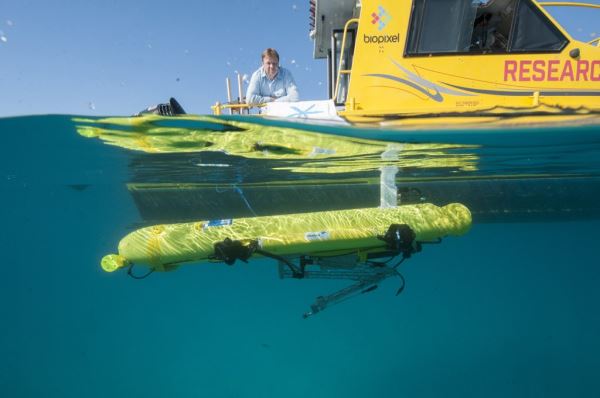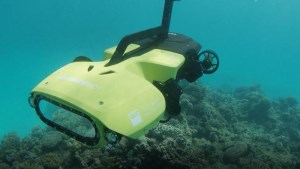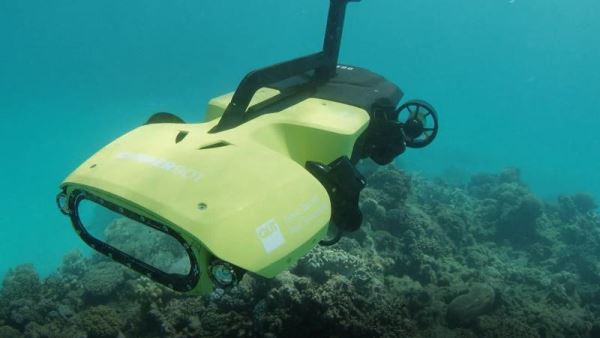An underwater drone that can keep watch on reef health and accurately identify and inject the devastating crown-of-thorns starfish is ready to be put to the test.
The RangerBot uses a hi-tech vision system to see underwater. This enables it to monitor coral bleaching and identify starfish activity.
The reef protection program is a collaboration between QUT, Google and the Great Barrier Reef Foundation.
RangerBot is a low-cost, autonomous robot that can be operated using a smart tablet. Weighing just 15kg and measuring 75cm, it takes only 15 minutes to learn how to operate it.
The concept won the 2016 Google Impact Challenge People’s Choice prize, enabling QUT roboticists to develop a “real-life” reef protector.
Launching RangerBot at Townsville’s Reef HQ Aquarium last week, QUT Professor Matthew Dunbabin said the technology was developed after almost two years of research, development and testing.
The industry-leading technology is now set to be put through its paces to monitor and protect the Reef.
“RangerBot is the world’s first underwater robotic system designed specifically for coral reef environments, using only robot-vision for real-time navigation, obstacle avoidance and complex science missions,” Professor Dunbabin said.
Valuable research tool
“This multifunction ocean drone can monitor a wide range of issues facing coral reefs including coral bleaching, water quality, pest species, pollution and siltation. It can help to map expansive underwater areas at scales not previously possible, making it a valuable tool for reef research and management.
“RangerBot can stay under water almost three times longer than a human diver, gather more data, and operate in all conditions and at all times of the day or night, including where it may not be safe for a human diver.”
The robot is fitted with computer vision to ‘see’ where it’s going and avoid obstacles as well as multiple thrusters so it can move in every direction.
“We’ve ‘trained’ RangerBot to detect crown-of-thorns starfish – and only these coral-destroying starfish – in much the same way as people learn to differentiate between various forms of sea life,” Professor Dunbabin said.
“Using real time computer vision processed on board the robot, RangerBot can identify these deadly starfish with 99.4% accuracy.
“Once the identification is confirmed, RangerBot can instigate an injection which is fatal for the crown-of-thorns starfish, but doesn’t affect anything else on the reef.”
Significant technology leap
Professor Dunbabin said unlike single-purpose marine robots – which are more manual and based on expensive acoustic technologies – RangerBot uses innovative vision-based technologies.
“We believe this represents a significant technology leap in both marine robotics and reef protection – the only autonomous, affordable, multi-function solution for effectively detecting and addressing threats to coral reefs,” he said.
RangerBot was deliberately developed at minimum cost, to allow production to be scaled up when operational testing is completed and necessary approvals are in place.
“Our vision is to make RangerBots readily available and accessible to be deployed on the Reef where they’re most needed and to put them in the hands of reef managers, researchers and communities worldwide,” Professor Dunbabin said.
More than a billion people depend on coral reefs
“Environmental robotics is a real passion of ours and we see so much potential for these advanced technologies to transform the way we protect the world’s coral reefs,” he said.
By winning the People’s Choice award at the Google Impact Challenge, the consortium secured $750,000 to take the project to the next level.
“Combining the expertise of innovators like Google and QUT, this project is a great example of harnessing technology to benefit the Reef,” said Great Barrier Reef Foundation Managing Director Anna Marsden.
“More than a billion people depend on coral reefs for their food and livelihood – they stand to lose the most if those important ecosystems are not protected,” she said.
Potential to revolutionise reef management
“Even though the Great Barrier Reef is internationally acknowledged as the best managed reef globally, due to its size and complexity, effective management is a mammoth and expensive task.”
Ms Marsden said RangerBot has the potential to revolutionise the way we manage our oceans.
The Australian Institute of Marine Science (AIMS) recently took part in trials with RangerBot on the Great Barrier Reef. AIMS is investigating new technology to boost its data collection and underwater observation capabilities to improve the health of coral reefs.
RangerBot’s capabilities have been extensively tested both in the lab and on the Reef. The next steps will involve further collaboration with the Great Barrier Reef Marine Park Authority, AIMS and others on the specific testing, review and approvals necessary to ensure RangerBot is set to take on Reef duty.


